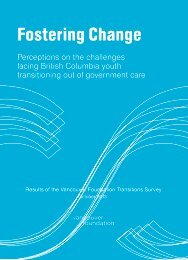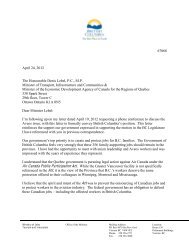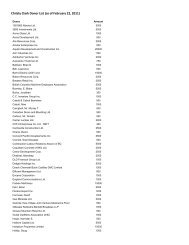from the ground up - The Tyee
from the ground up - The Tyee
from the ground up - The Tyee
Create successful ePaper yourself
Turn your PDF publications into a flip-book with our unique Google optimized e-Paper software.
When it comes to meeting our future electricity needs,BC Hydro has a few options: Increase system efficiency(“Resource Smart”), develop Site C, pay fornew s<strong>up</strong>ply via long-term contracts, or invest in conservation.Conservation is cheapest, and so BC Hydrowill continue to spend increasing amounts on demandside management (DSM) this decade. But <strong>the</strong> electricityyou avoid using still costs money.Jaccard is <strong>the</strong> co-author of an unpublished December2010 study that investigated whe<strong>the</strong>r <strong>the</strong> money spenton Canadian utility “subsidies” (like a rebate to buyan efficient appliance) actually works, and he says <strong>the</strong>news is not good. “DSM expenditures by Canadianelectric utilities have had only a marginal effect onelectricity sales,” <strong>the</strong> report concludes.Yet residential rebate programs remain popular withpoliticians, utility executives and <strong>the</strong> public, Jaccardsays, because <strong>the</strong>y make us all feel good about conservation.<strong>The</strong> only problem is that our energy consumptionkeeps growing in spite of <strong>the</strong>se measures,while utilities continue to oversell <strong>the</strong> benefits.Most utilities can only infer <strong>the</strong> impact of this spending.This is because many of <strong>the</strong> people who actuallyuse <strong>the</strong> rebates -- referred to as “free riders” -- are <strong>the</strong>same people who would buy <strong>the</strong> appliance in <strong>the</strong> absenceof <strong>the</strong> rebate. “Free riders add to <strong>the</strong> utility costof a subsidy program without contributing to its effectiveness,”says Jaccard’s report, which highlights a2004 U.S. study that estimated an “overall free ridershiprate of 50-90 percent,” based on a considerationof all utility DSM programs in all sectors.<strong>The</strong>n <strong>the</strong>re is <strong>the</strong> “rebound effect” -- when <strong>the</strong> improvedenergy efficiency of a given appliance, technology,etc. reduces <strong>the</strong> cost of using that device to<strong>the</strong> point that it actually spurs greater energy use. Soour lives are filled with increasingly energy-efficientdevices, but we have many more of <strong>the</strong>m, consumingever-greater amounts of electricity.Jaccard’s prescriptionMoney would be better spent, says Jaccard, focusingour efforts on “radical rate design” and regulationsthat force manufacturers to build efficiency into <strong>the</strong>irproducts.BC Hydro has already moved to what are called ConservationRates -- most of us now pay two separateprices for electricity -- a lower rate for a set period oftime, followed by a second, more expensive rate thatkicks in after a set period of consumption.Jaccard says <strong>the</strong> setting of that higher rate by BCHydro has been too conservative. This “top step”rate needs to go way <strong>up</strong>, and reflect <strong>the</strong> full costs ofbringing new s<strong>up</strong>ply online; this could see <strong>the</strong> highestrate moving into <strong>the</strong> 12-15 cents/kWh range. (Onmy February 2011 residential BC Hydro bill, <strong>the</strong> firstand second steps were 6.2 cents and 8.7 cents/kWhrespectively).On <strong>the</strong> subject of standards and regulations, Jaccardsays BC Hydro has made progress here too. A case inpoint is <strong>the</strong> new lighting efficiency standards that willsee <strong>the</strong> phase-out of incandescent light bulbs.“[BC Hydro] has started to realize that it’s better togive <strong>the</strong> money to encourage manufacturers or retailersin a certain direction, ra<strong>the</strong>r than final customers,”says Jaccard.<strong>The</strong>y’re doing it in CaliforniaCalifornia leads <strong>the</strong> way in North America when itcomes to <strong>the</strong> types of regulations and “standards” Jaccardrefers to. Since <strong>the</strong>y emerged in <strong>the</strong> early 1970s,<strong>the</strong> state’s building and appliance efficiency standardshave made California <strong>the</strong> most energy efficient state.“Our per capita energy consumption has been absolutelyflat for nearly 40 years, and this is directlybecause of <strong>the</strong>se standards,” says Adam Gottlieb,spokesperson for <strong>the</strong> California Energy Commission,<strong>the</strong> state’s primary energy policy and planning agency.He says standards for everything <strong>from</strong> air conditionersto fridges have enabled Californians to consume anaverage 7,400 kWh of electricity annually while <strong>the</strong>rest of <strong>the</strong> country averages at 12,000. (Note: a typicalBC household -- 1,600 square feet, not reliant onelectricity for space or water heating -- currently usesabout 14,000 kWh.)California’s utilities -- a broad mix of public andprivately-owned concerns, reliant on everything <strong>from</strong>imported coal power and hydro, to locally-generatedpower <strong>from</strong> natural gas and nuclear -- still spend a61








